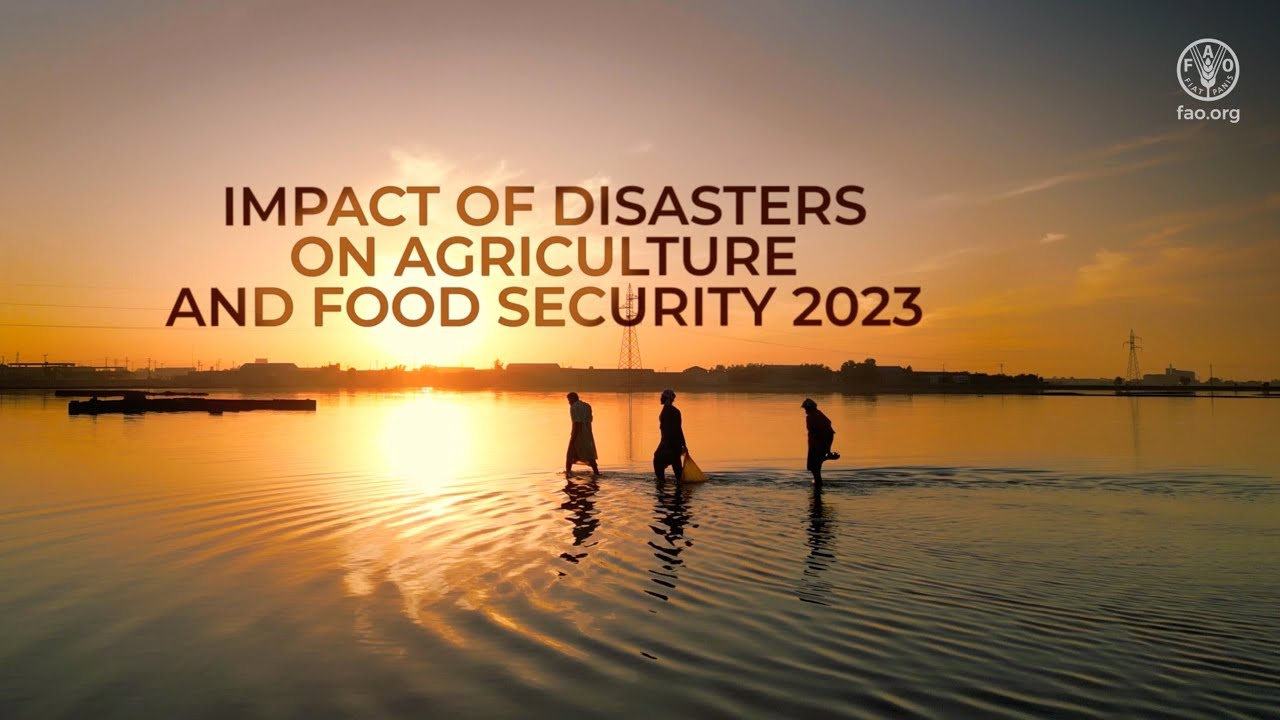Description

Copyright infringement not intended
Picture Courtesy: Food and Agriculture Organization
Context: The Food and Agriculture Organization (FAO) released a report highlighting the significant economic losses in agriculture caused by natural disasters over the past 30 years.
Key Highlights of the Report
- Natural disasters pose significant challenges to global agricultural production, affecting crops, livestock, and livelihoods. The recent report by the Food and Agriculture Organization (FAO) sheds light on the extensive economic losses incurred due to these disasters over the past three decades.
- The FAO report also outlines crucial priorities, emphasizing the need for proactive measures to enhance agriculture's resilience and mitigate the impact of future natural disasters on global food production.
Economic Impact of Natural Disasters on Agriculture
- The FAO report reveals staggering figures: an estimated $3.8 trillion worth of crops and livestock production lost due to natural disasters in the last 30 years.
- This amount, averaging $123 billion per year, accounts for 5% of the annual global agricultural gross domestic product (GDP).
- These losses are not evenly distributed across agricultural products. Cereals, fruits and vegetables, sugar crops, meats, dairy products, and eggs have all experienced significant average losses.
|
Cereals
|
●Cereals are essential food crops like wheat, rice, and maize, providing vital carbohydrates for human consumption and livestock feed, but their consistent production loss poses a threat to global food security.
●The report notes an average loss of 69 million tonnes per year over the past three decades. This quantity is equivalent to the entire cereal production of France in 2021, signifying a substantial setback to global food security.
|
|
Fruits, Vegetables, and Sugar Crops
|
●Fruits, vegetables, and sugar crops, essential for a balanced diet, are facing average annual losses of 40 million tonnes, equivalent to the entire production of these items in countries like Japan and Vietnam in 2021, highlighting a severe nutritional challenge.
●These losses pose substantial challenges for nations heavily dependent on these crops, impacting both domestic food supplies and exports, emphasizing the broader economic repercussions of declining fruit and vegetable production.
|
|
Meats, Dairy Products, and Eggs
|
●Livestock products such as meats, dairy, and eggs, crucial protein sources for many people, are experiencing an annual loss of 16 million tonnes, equivalent to the entire production of these items in significant countries like Mexico and India in 2021.
●The decline in these livestock-related products raises serious concerns about food security, emphasizing the urgent need for strategies to address the losses, ensuring a stable supply of essential proteins for populations worldwide and preventing
|

Regional Disparities in Agricultural Losses
- Natural disasters affect agriculture differently in different parts of the world. Asia suffered the most economic losses, but Africa, Europe, and the Americas also faced significant challenges due to these disasters.
- Despite Asia having the largest economic losses, these losses were a smaller part of its agricultural value compared to Africa. This shows that economic factors, how well regions are prepared for disasters, and the way agriculture is practiced locally, all interact in complex ways during natural disasters.
|
Asia
|
●Despite being hit hard, Asia's agricultural losses only made up 4% of its total agricultural value. This highlights the region's robust agricultural output and diverse economy, enabling it to handle losses more resiliently compared to other areas.
●Asia's ability to absorb these losses showcases its economic strength and adaptability. The region's vast agricultural production and economic diversity have contributed to its resilience in the face of significant agricultural challenges.
|
|
Africa
|
●Africa faced significant agricultural losses amounting to almost 8% of its agricultural value. This high percentage highlights the vulnerability of the region to natural disasters and agricultural challenges.
●The considerable losses underscore the necessity for focused interventions and efforts to enhance resilience in Africa. Immediate support and strategies are crucial to help the region cope with these challenges effectively.
|
|
Americas and Europe
|
●The Americas and Europe experienced moderate agricultural losses due to natural disasters. Despite these losses, their economic resilience enabled them to handle the impact better than Asia and Africa.
●These regions, while affected, managed to absorb the challenges more efficiently, showcasing their economic stability. This adaptability highlights the importance of robust economic structures in mitigating the effects of agricultural losses.
|
Factors Contributing to Vulnerability
Climate Change and Extreme Weather Events
- The number of global disaster events has quadrupled since the 1970s, reaching about 400 per year in the last two decades, disproportionately affecting small farmers relying on rain-fed agriculture, making them highly vulnerable to these impacts.
- Climate change is causing more frequent and severe extreme weather events like hurricanes, droughts, floods, and heatwaves. These events are disrupting farming, damaging crops, and hurting livestock, resulting in substantial economic losses.
- Extreme weather events, intensified by climate change, are negatively affecting agriculture by harming crops and livestock. This damage not only disrupts farmers' livelihoods but also leads to significant economic setbacks due to agricultural losses.
Dependency on Natural Resources
- Agriculture relies on natural resources like water, soil, and suitable weather. These resources are essential for farming but are negatively affected by disasters such as droughts and soil erosion, directly reducing agricultural productivity.
- Disasters harm vital resources, jeopardizing agriculture's sustainability and economic stability. When natural resources are compromised, it becomes challenging for farmers to sustain their livelihoods and maintain a stable agricultural economy.
Limited Access to Technology and Resources
- Small farmers in poorer countries often do not have access to modern farming tools, strong plant varieties, or enough money. This lack of technology makes them vulnerable to natural disasters, making it harder for them to protect their crops.
- Limited access to financial resources further compounds the issue for small-scale farmers. Without funds, they struggle to recover after disasters, intensifying the overall economic impact and perpetuating the cycle of vulnerability.
Building Resilience in Agriculture
- The FAO report identifies essential priorities for action to enhance resilience in agriculture and mitigate the impact of natural disasters. These priorities offer a roadmap for policymakers, agricultural practitioners, and communities to proactively address the challenges posed by climate-related disasters.
Improving Data and Information
- Having precise information about disaster impacts is crucial. It helps identify vulnerabilities and enables policymakers to create effective plans. Accurate data forms the foundation for understanding the problem.
- Improved data collection and analysis allow policymakers to make smart decisions. It helps them allocate resources wisely and focus efforts where they're most necessary, ensuring interventions are effective in reducing the impact of disasters.
Multisectoral and Multi-Hazard Disaster Risk Reduction
- Addressing disaster risks across different sectors is vital. This means considering various threats like climate change, extreme weather, and geological factors.
- A holistic approach involving agriculture, forestry, fisheries, and aquaculture can build a strong and resilient framework to handle diverse challenges.
- By integrating disaster risk reduction strategies across multiple areas, policymakers can create a robust system. This approach ensures that communities are better prepared to face different hazards, enhancing overall resilience and minimizing the impact of disasters.
Investments in Resilience
- Increasing investments in resilience is vital. This can involve developing crops that can withstand climate challenges, creating infrastructure to prevent soil erosion and flooding, and setting up early warning systems. These investments are essential to decrease disaster risks significantly.
- Allocating resources not only reduces the impact of disasters but also boosts agricultural productivity. Farmers' lives improve as they can better cope with challenges, leading to more stable and secure livelihoods in farming communities.

Conclusion
- The FAO report highlights the pressing need for global cooperation among policymakers, researchers, and communities to take proactive measures, make strategic investments, and implement multidisciplinary approaches, ensuring a resilient, sustainable, and secure agricultural future in the face of natural disasters.
Must Read Articles:
CLIMATE CHANGE AND HEALTH HUB: https://www.iasgyan.in/daily-current-affairs/climate-change-and-health-hub#:~:text=Climate%20change%20impacts%20health%20both,social%20and%20public%20health%20determinants.&text=Between%202030%20and%202050%2C%20climate,malaria%2C%20diarrhoea%20and%20heat%20stress.
CLIMATE CHANGE AND SUBSIDIES: https://www.iasgyan.in/daily-current-affairs/climate-change-and-subsidies
|
PRACTICE QUESTION
Q. How is climate change impacting agriculture, and what are the key strategies and innovations being employed to adapt to and mitigate its effects on food production and security?
|















